
An Article from the August 2003 JOM: A Hypertext-Enhanced Article
 |
TMS
ONLINE | TMS
PUBLICATIONS | SITE
MAP An Article from the August 2003 JOM: A Hypertext-Enhanced Article |
|
|
|
|
N. Kanari and J.-L. Pineau are with the Mineral Processing and Environmental Engineering Team, Laboratoire Environement et Minéralurgie, rue du Doyen M. Roubault, BP 40, 54501 Vandœuvre Cedex, France; S. Shallari is with the University of Tirana in Albania.
|
Exploring traditional, innovative, and revolutionary issues in the minerals,
metals, and materials fields.
|
| OUR LATEST ISSUE |
|
Automobile manufacturing has increased in the last 20 years, reaching about 58 million units (excluding commercial vehicles) in 2000 (see Figure 1). According to estimates by the Organization for Economic Cooperation and Development (OECD), the total number of vehicles in OECD countries was expected to grow by 32% from 1997 to 2020. Automobile production is more or less equally distributed between North and South America, Europe, and Asia.1
|
|
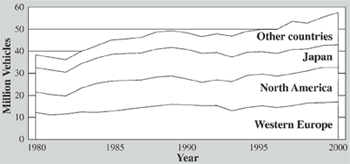
|
|
Figure 1. World automotive production from 1980 to 2000.1 |
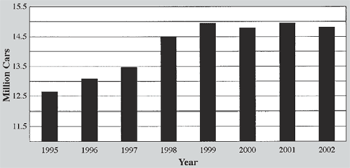 |
Figure 2. Passenger car production in the European Union.2 |
The evolution of passenger car production in the European Union (E.U.) from 1995 to 2002 is shown in Figure 2. More than 14.5 million cars per year have been manufactured since 1998,2 with total automobile production (passenger cars, light commercial vehicles, trucks, and buses) in 2002 close to 17 million units. Most of the car production is concentrated in Germany, France, Spain, Italy, and Great Britain.
According to the available data,1 about 160 million cars were in use in the European Union in 1995, and in 2001, that number exceeded 180 million units. More than 80% of these cars were concentrated in the five countries previously mentioned as major producers. The increasing car production and use data indicate the importance of the automobile industry in society.
However, that industry is facing a number of serious challenges related essentially to its impact on the environment. Vehicles affect the environment through their entire life cycle. Consumption of energy and resources, waste generation, greenhouse gases, hazardous substance emissions, and disposal at the end of their lives are burdens created by automobile production and use.
This paper deals with the recycling of end-of-life vehicles (ELV) in the European Union.
Recycling of ELV incorporates the recycling itself, recovery, and reuse. The driving force, criteria, and concept for ELV recycling result from different factors that have changed with time. For example, development of the electric arc furnace in the 1960s–1970s dramatically increased the use of vehicle shells as input scrap. Later, production of high-quality steel required the use of vehicle scrap free of nonferrous metals, prompting the magnetic separation of ferrous from non-ferrous metals. Further, the separation and recovery of aluminum from ELV was more energy efficient than production of aluminum from its ores.
Today, recycling of ELV is driven not only by economic and technological factors but also by social and environmental concerns. In other words, the automobile industry is shifting toward sustainable waste management.
Recycling options for ELV are related to the material used for vehicle manufacturing as well as the assembly of its components. Vehicle composition has been shifting toward light materials such as aluminum and polymeric constituents. As mentioned by Zoboli et al.,3 in 1965 the total weight of a European car included about 82% ferrous and non-ferrous metals (2% aluminum) and 2% plastics. In the mid-1980s, the content of ferrous and non-ferrous metals averaged 74–75% (with 4.5% aluminum) and plastics were estimated at 8–10% of a European car’s weight. The use of lighter materials (aluminum and plastics) improved fuel economy and reduced emissions. It is believed that a 100 kg weight reduction of a vehicle results in a fuel savings of about 0.7 L/100 km. However, introducing lighter materials to vehicles also compensates for weight increases resulting from new comfort and safety features.
The average composition of the E.U. car4 in 1998 is illustrated in Figure 3, which clearly shows the increase of aluminum content (~8%) in the total car weight. Ferrous and non-ferrous metals (Zn, Cu, Mg, and Pb) constitute about 67.5% of the vehicle. This figure also depicts the plastics used in average cars (~9.3%), their applications in the car body, and the major type of plastic used (polyvinyl chloride, polypropylene, polyurethane rubber, etc.).
Taking into account that the average lifespan of a car in use is between 12 and 15 years, the composition of the car represented in Figure 3 will be recycled in the next decade in E.U. countries. Similarly, ELV in the recycling chain today were manufactured in the 1980s–1990s.
|
|
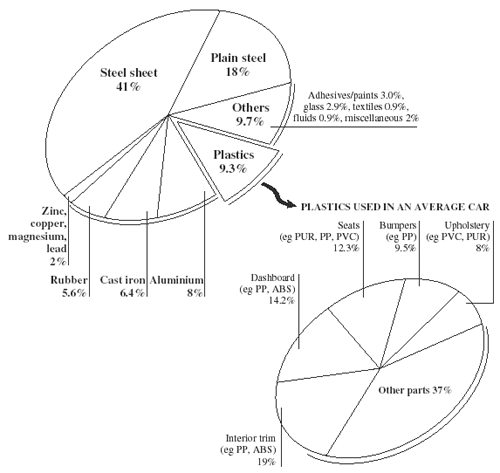
|
|
Figure 3. Material used in European Union car production (1998).4 |
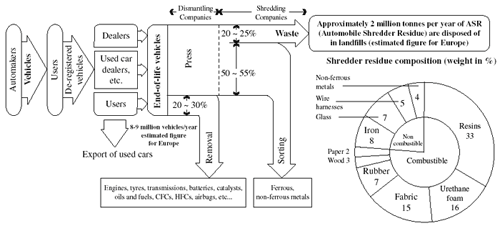 |
Figure 4. The disposal route for end-of-life vehicles.5 |
An overall schema5 of the vehicles’ paths starting from automakers to disposal of the shredder residue is shown in Figure 4. The last car owners (i.e., users) are the starting point for the ELV chain. After de-registering the vehicles, the users can deliver their old cars to the dealers and/or to used-car dealers. The dealers, in turn, deliver the used cars to collectors/dismantlers. The deregistration of used cars can be done by users, dealers, collectors, and/or dismantlers, depending on the county rules.
About 8 million to 9 million ELV per year are estimated to be recycled in the E.U. countries. But, as noted by Zoboli et al.,3 the actual number could be less than the official figure. This is due to significant export flows of ELV as second-hand cars from E.U. countries to non-E.U. countries in regions such as Eastern Europe, the former Soviet Union, and North Africa. Higher profits from selling these used cars intact rather than as spare parts and materials in the European Union can explain this phenomenon.
Collecting and dismantling companies focus on removing valuable spare parts and other components such as engines, batteries, oils and fuels, and airbags. Although these companies are essential to the reduction of ELV waste, they are small companies that are mostly interested in ELV parts that are suitable for reuse, recycling, or sale. The ELV dismantling is often done improperly, increasing the amount and toxicity of ELV waste. After dismantling, the remainders of the ELV, so-called “hulks,” are processed by shredding companies.
After the hulks are shredded, the obtained materials undergo a series of mechanical and physical separations in order to recover the ferrous and non-ferrous metals. The residual of the shredding process, automobile shredder residue (ASR), represents about 20–25% of the ELV weight. Its average composition is given in Figure 4.
The ELV recyclable rate of 75–80% is higher than that of simpler products such as glass containers, newspapers, and/or aluminum beverage cans.6 One may emphasize that a passenger car contains about 15,000 parts.
The ASR is the weak point of ELV recycling not only in the European Union but also in the worldwide automobile industry. About 2 millions tonnes of ASR are generated per year in E.U. countries. In fact, it represents less than 1% of the total waste generated in the European Union. The ASR, while toxic enough to be classified as hazardous waste in many countries, could be considered an energy source as it contains more than 7% combustible matter (see Figure 4).
|
|
||
|
Country |
Cost ($/t)
|
|
|
E.U. countries
|
||
| Austria |
140
|
|
| Belgium |
55
|
|
| Denmark | ||
| France | ||
| Germany | ||
| Italy | ||
| Netherlands | ||
| Spain | ||
| Sweden | ||
| United Kingdom | ||
|
Eastern European countries
|
||
| Poland | ||
| Czech Republic | ||
|
Non-E.U. countries
|
||
| Australia | ||
| Japan | ||
| Norway | ||
| United States | ||
| South Africa | ||
| Switzerland | ||
|
|
||
As shown by Table I,3 the cost to dispose of ASR in a landfill is different in the selected countries. The disposal cost in Germany is at least two times higher than in the United Kingdom. The high cost of disposal to landfill was one of the driving forces in the diversion of ASR from waste disposal toward more eco-efficient treatments. Shredder companies in Germany are ultimately responsible for reducing ASR and also for the environmental damage resulting from landfilling of that waste product. Environmental policies of the German automobile industry are considered a model for future automobile stakeholders to minimize vehicle life cycle environmental impacts. Tight regulations in Germany for the ELV waste may be explained, among other factors, by the important role of the automobile industry in the country economy.
Considerable national policies and voluntary agreements by major automobile manufacturers have been developed concerning the environmental impact of vehicles over their lifetimes. At the end of 1999, ten E.U. member countries (Austria, Belgium, France, Germany, Italy, the Netherlands, Portugal, Spain, Sweden, and the United Kingdom) had specific regulations and/or industrial voluntary agreements addressing ELV. These countries represent almost 96% of ELV estimated to be in the European Union.3
The directive of European Parliament and of the Council of 18 September 20007 organized former national policies and voluntary agreements. It was aimed to harmonize these existing rules and to push the E.U. governments and automobile industry to comply fully with the directive and to translate its key requirements into national law. The essential part of this ELV directive is given in the following (Article 7).7 The ultimate goal of this directive is to put only 5% of ELV residues (ASR) into landfills. It states:
Waste prevention, re-use, recycling, and recovery of the ELV constituents so as to reduce ASR waste disposal are the objectives of the E.U. directive. Figure 5 is a schematic representation of the participants in the ELV chain, according to the E.U. directive. The main actor is the producer, a vehicle manufacturer or professional importer of a vehicle into a member state of the European Union. The producer links the upstream (supplier) and downstream in the ELV chain (collector, dismantler, and shred-der). On the other hand, collaboration between collector, dismantler, and shredder are necessary to successfully meet the directive goals.
The vehicle produced has to at least meet the following goals: low energy consumption, easy dismantling, suitable recycling, and less toxic metals (as shown in Figure 5). To fulfill these goals, the producer has to know the technical and economical facilities, recyclability rate, and efficiencies of the downstream ELV chain. On the other hand, the producer will provide the dismantling information for each new type of vehicle put on the market. The design of vehicles appropriate for dismantling, recycling, and re-use, and free of some hazardous substances [Pb, Hg, Cd, and Cr(VI)] will significantly improve the cooperation of the supplier-producer chain.
|
|
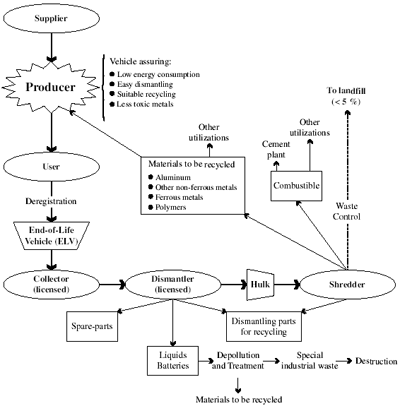
|
|
Figure 5. Major steps for ELV recycling according to the E.U. directive. |
The directive required that the ELV collector and dismantler be certified (licensed), and as a result, the number of licensed dismantlers in the European Union has increased significantly, exceeding 1,000 licensed enterprises per country in the top five producers of vehicles in the European Union. The dismantler’s role is the removal for sale of re-usable parts such as engines, transmissions, gearboxes, and body parts. According to the ELV directive, removing pollutants from the vehicle becomes an important task of the dismantler business. This involves the draining of liquids and removing of environmentally harmful constituents such as the battery. Furthermore, dismantlers are certified to destroy the waste resulting from removing the pollutants (i.e., depollution) (Figure 5). These tasks by the dismantler will facilitate the subsequent hulk shredding and will reduce the ASR generated by the shredder operators.
Shredding steps include dismantling small parts for recycling, hulk shredding, and ferrous and non-ferrous metal separation. The separated materials will likely go to automakers for use in the production of the same components from which they are issued. Energy can be recovered from combustible parts of ELV by using them instead of fossil fuels in industrial operations, such as cement plants. The remaining part of the vehicles, ELV waste, will go to a landfill under strict waste control. This will be material for which there is not justification for recovery.
In an increasingly global economy, the goals of the E.U. directives are becoming a sensitive issue for worldwide vehicle production. The regulatory approach to automobile recycling in Japan is compared with the E.U. directive in Table II.8 It is clear that most of the selected items (i.e., schedule, car manufacturer’s obligations, costs) are similar. In both cases, the car manufacturer has an essential role in the infrastructure system of waste prevention, collection, and treatment of ELV.
|
|
|||
|
|
Japan (Automobile Recycling Law)
|
E.U. (ELV Directive)
|
|
Schedule |
Promulgated July 2002, to enter
effect by January 2005 |
Effective from October 2000
legislation enacted in E.U. member
states in 2002 |
|
Vehicle covered |
Four-wheeled passenger cars and
commercial vehicles (including
everything from mini-cars to large
trucks and buses) |
Passenger cars with seating capacity
of nine or less and commercial vehicles
with gross vehicle weight of 3.5 t
or less |
|
Car manufacturer’s
obligations |
Collection and disposal of
fluorocarbons and airbags
Collection and recycling of shredder residue Setting and publication of user charges |
Establishment of ELV collection
and recycling network
From July 1, 2002: Newly registered vehicles. From January 1, 2007: All ELVs Prohibition of use of hazardous substances (lead, mercury, cadmium, hexavalent chromium). Covering all vehicles sold from July 1, 2003 |
|
| Design and manufacture of car models with consideration for environment and recycling | Recyclability rate 95% or more | ||
Costs |
Deposited by users (managed by fund
management corporation) New vehicles: deposited at time of sale Old vehicles: deposited at time of automobile inspection (depending on country) |
All or most of cost borne by car manufacturers | |
|
|
|||
References
1. Anonymous, “Industry as a Partner for Sustainable
Development, Automotive Report,” ACEA, JAMA and
AAM (Published in the U.K., 2002).
2. “Auto Data, Automotive Production (Historical
Series: 1995–2002 by type)” (Brussels, Belgium:
ACEA, 2003), www.acea.be/ACEA/index.html (loaded
in April 2003).
3. R. Zoboli et al., “Regulation and Innovation in the Area
of End-of-Life Vehicles,” EUR 19598 EN, ed. F. Leone
(Milan, Italy: IDSE-CNR, March 2000).
4. “Plastics: A Material of Choice for the Automotive
Industry” (Brussels, Belgium: Association of Plastics
Manufacturers in Europe, 1999), www.apme.org (loaded in April 2003).
5. “Car Recycling-Europe,” Toyota Motor Marketing
Europe (2002), www.toyota-europe.com (loaded in
April 2003).
6. K. Bellmann and A. Khare, “European Response to
Issues in Recycling Car Plastics,” Technovation, 19
(1999), pp. 721–734.
7. Directive 2000/53/EC of the European Parliament
and of the Council of 18 September 2000 on end-of life
vehicles. Official Journal of the European Communities (21 October 2000).
8. Anonymous, Mitsubishi Motors Environmental
Sustainability Report 2002 (Tokyo: Mitsubishi Motors,
October 2002).
For more information, contact N. Kanari, L.E.M., BP 40, 54501 Vandœuvre, France; e-mail Ndue.Kanari@ensg.inpl-nancy.fr.
Direct questions about this or any other JOM page to jom@tms.org.
| Search | TMS Document Center | Subscriptions | Other Hypertext Articles | JOM | TMS OnLine |
|---|